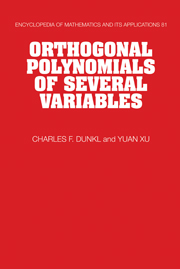Book contents
- Frontmatter
- Contents
- Preface
- 1 Background
- 2 Examples of Orthogonal Polynomials in Several Variables
- 3 General Properties of Orthogonal Polynomials in Several Variables
- 4 Root Systems and Coxeter groups
- 5 Spherical Harmonics Associated with Reflection Groups
- 6 Classical and Generalized Classical Orthogonal Polynomials
- 7 Summability of Orthogonal Expansions
- 8 Orthogonal Polynomials Associated with Symmetric Groups
- 9 Orthogonal Polynomials Associated with Octahedral Groups and Applications
- Bibliography
- Author index
- Symbol index
- Subject index
2 - Examples of Orthogonal Polynomials in Several Variables
Published online by Cambridge University Press: 17 December 2009
- Frontmatter
- Contents
- Preface
- 1 Background
- 2 Examples of Orthogonal Polynomials in Several Variables
- 3 General Properties of Orthogonal Polynomials in Several Variables
- 4 Root Systems and Coxeter groups
- 5 Spherical Harmonics Associated with Reflection Groups
- 6 Classical and Generalized Classical Orthogonal Polynomials
- 7 Summability of Orthogonal Expansions
- 8 Orthogonal Polynomials Associated with Symmetric Groups
- 9 Orthogonal Polynomials Associated with Octahedral Groups and Applications
- Bibliography
- Author index
- Symbol index
- Subject index
Summary
Before we study the theory of orthogonal polynomials in several variables, we give various examples of families of orthogonal polynomials in several variables in this chapter. More detailed study on some of the families will be given in later chapters, here we deal with the basic properties.
Notation and Preliminary
Throughout this book, we will use the standard multi-index notation. We denote by ℤ0 the set of nonnegative integers. A multi-index is usually denoted by α, α = (α1, …, αd) ∈ ℤd0. Whenever α appears with subscript, it means a multi-index. In this spirit we define, for example, α = α1… αd and |a| = α1 + …+ αd; and if α, β ∈ ℤd0, then we define For∈ ℤd0 and x = (x1, …, Xd), a monomial in variables x1, …Xd is a product
The number |a| is called the total degree of xα. A polynomial P in d variables is a linear combination of monomials,
where the coefficients cα are in a field κ, usually the rational numbers ℚ, the real numbers ℝ or the complex numbers ℂ. The degree of a polynomial is defined as the highest total degree of its monomials. The collection of all polynomials in x with coefficients in κ is denoted by κ[x1, …, xd], which has the structure of a commutative ring. We shall use the abbreviation ∏d to denote κ[xi, …,xd]. We also denote the space of polynomials of degree at most n by. When d = 1, we drop the superscript and write ∏ and ∏n instead.
Information
- Type
- Chapter
- Information
- Orthogonal Polynomials of Several Variables , pp. 30 - 62Publisher: Cambridge University PressPrint publication year: 2001
Accessibility standard: Unknown
Why this information is here
This section outlines the accessibility features of this content - including support for screen readers, full keyboard navigation and high-contrast display options. This may not be relevant for you.Accessibility Information
- 1
- Cited by
